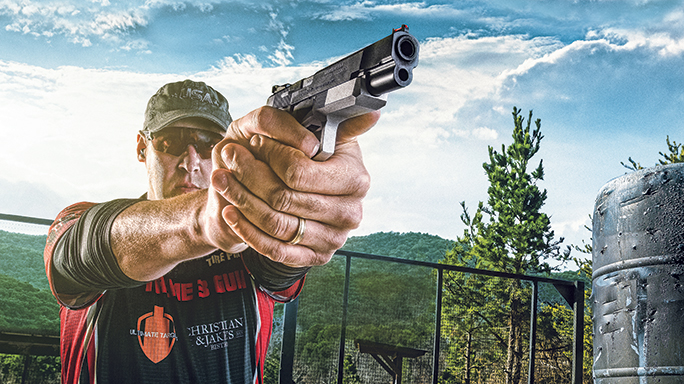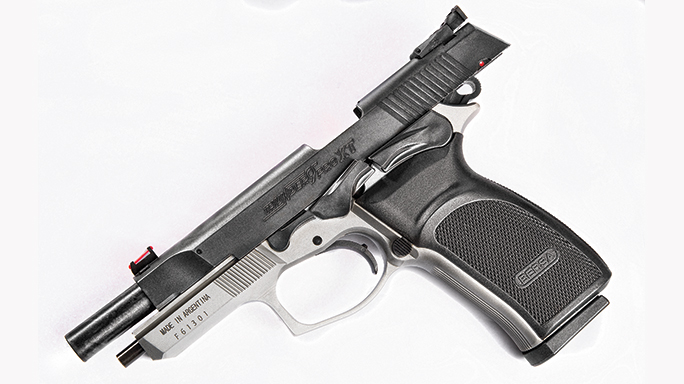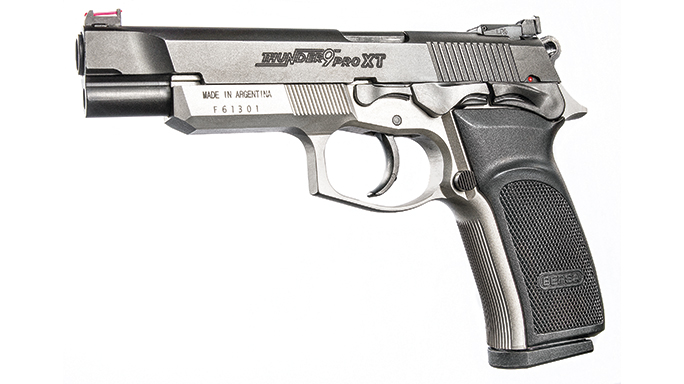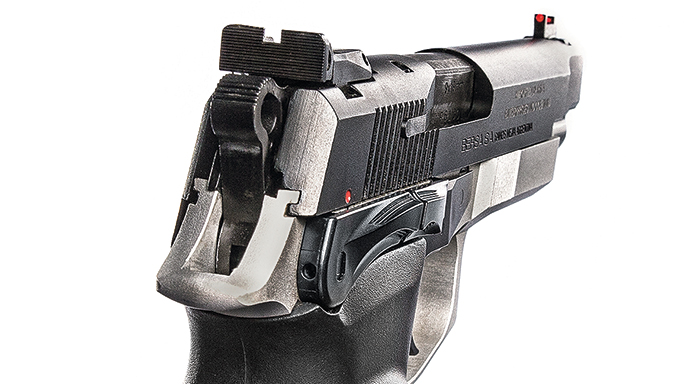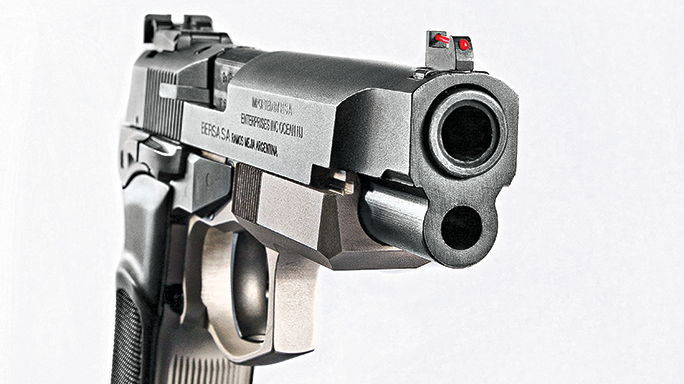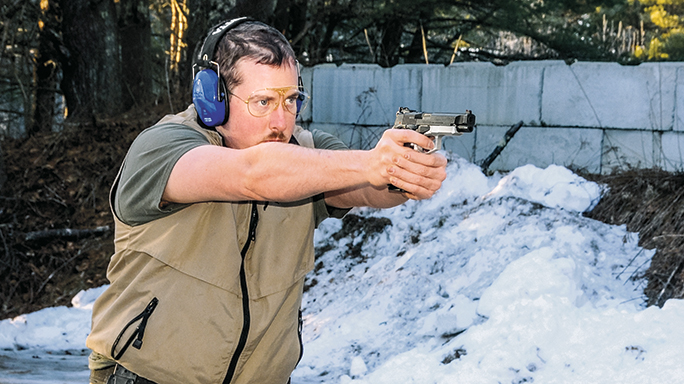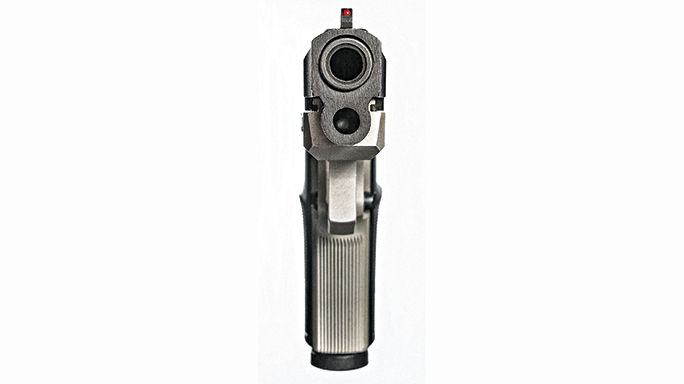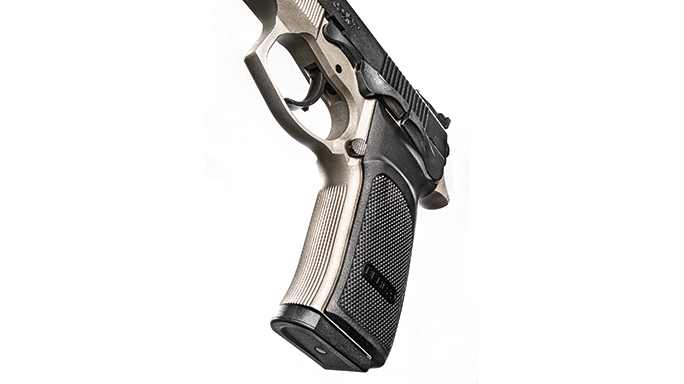Rarely am I so taken with a pistol as I was with the 9mm Bersa Thunder 9 Pro XT. There’s something about the way it fits in with leading trends while standing out through its embrace of older designs—like its double-action/single-action (DA/SA) operation. It’s a bold pistol designed specifically for action shooting and range fun, yet it retains the ability to fight if the need arises.
Solid Design
The “Thunder 9 Pro XT” name places this pistol squarely in Bersa’s lineage: It has the familiar controls of the Thunder double-stack guns and is essentially a long-slide, extended version—hence “XT”—of the Pro, featuring an extra half-inch of barrel and slide. In fact, the pistol sports a 4.96-inch barrel to get the most velocity from 9mm ammunition.
Advertisement — Continue Reading Below
- RELATED STORY: The 20 Best Guns For Law Enforcement in 2016
As for the gun’s construction, the wraparound grip is plastic, but everything else that’s black on the pistol is steel, including the slide and frame-mounted controls, the adjustable rear sight and even the fiber-optic front sight housing.
The silver surfaces are all part of the 7075-T6 aluminum frame. Everything aside from the grip panels is metal. That speaks to my latent prejudices and values that harbor an abiding appreciation for all-metal construction. There’s something in the heft, the impression of durability, of picking up an all-metal gun that I just like.
The 33.9-ounce weight of this palm- filling handgun feels solid, and the metal frame contributes to a pretty decent unloaded balance—a big plus for those who extensively dry fire or shoot in disciplines where magazines are downloaded. In plate rack drills with only six rounds in each magazine, there’s a noticeable improvement in balance compared to many of today’s polymer-framed guns.
Advertisement — Continue Reading Below
The sights are extremely nice, with a truly competition- grade LPA rear unit that is micro-adjustable for elevation and windage, and features horizontal texturing on the rear plane to eliminate glare. The front sight features a bright red fiber-optic insert within a steel housing to protect the rod in case the gun is slammed into barricades and scraped across synthetic holsters.
The sights are very easy to acquire, and my test pistol’s came preset for a center hold at 10 yards, which you can easily change to suit your range, ammunition or personal tastes.
Controls & Frame
Advertisement — Continue Reading Below
All of the controls are mounted on the frame. The safety/decocker lever and slide release are ambidextrous, and while the magazine release comes installed on the left side only, it’s reversible (and of all included magazines are cut for ambidextrous mag release use). The slide release and safety/decocker are sculpted in Bersa’s signature design. One thumb motion takes the pistol from whatever state you don’t want it in (on “safe” or locked open) to a ready-to-fire state (off “safe” or slide forward). That’s good for muscle memory and a huge improvement over slide-mounted safety/decockers.
To decock the pistol and put it in “safe” (or just put it in “safe” if the hammer is already down), just push upward on the safety. An internal firing-pin-blocking safety activates, then the hammer drops. You must manually lower the safety, which reveals the universal red dot to indicate its “fire” condition.
The rear of the trigger has a small, fixed bump that limits overtravel. There is approximately 4mm of overtravel after the DA trigger release, and only 2mm of overtravel after the SA release. The difference isn’t noticeable unless you really go looking for it.
Advertisement — Continue Reading Below
The front of the “combat triggerguard” is smooth, although many models today have some kind of grip-enhancing surface in this area for those shooters who use it as a control point.
The unique frame serrations above and forward of the triggerguard provide your trigger finger with a tactile reference point for resting it alongside the frame, especially when you’re running between targets.
The underside of the frame’s dust cover is slick, lacking the Picatinny accessory rail so common on today’s pistols. Action shooting rarely requires lights or the like, so the average shooter probably won’t miss it.
Advertisement — Continue Reading Below
Now, the grip is my favorite aspect the Thunder 9 Pro XT’s design. While I dislike its plastic feel, I absolutely love the details. Slight rests are molded into each side of the grip to guide your thumb and trigger finger. That’s clever.
Above the rests, the grips are smooth so that when your thumb activates any of the controls, it won’t be slowed down or abraded by traction-enhancing surfaces like those found lower on the grip. That’s really clever.
The grips slope in towards the frame, naturally guiding your thumb towards solid interaction when engaging the safety or slide stop. These angles of approach make one-handed operation very easy, and reflect the extremely close attention to detail paid to the pistol’s overall design.
Advertisement — Continue Reading Below
Any Accessories?
The Thunder 9 Pro XT ships with the spent casing in a sealed envelope that is required in some states and jurisdictions, along with information on firearm safety. No trigger lock was included with my test model. Everything arrived in a very nice blue plastic case with ample room for the pistol and its five 17-round magazines. That’s right—five magazines.
- RELATED STORY: Bersa’s Firestorm .380 Concealed Carry Returns to California
The one thing you’ll really need is a good holster. Most leather holsters for full-sized CZ, Tanfoglio or Beretta handguns should do the trick just fine. The challenge is finding a competition-ready Kydex holster—one of the offset, fully adjustable kinds that competition guns love. I haven’t had any success locating one yet, though hope springs eternal, and until then, I have plenty of generic holsters that work.
Advertisement — Continue Reading Below
Most Kydex magazine pouches sized for Beretta M9 and similar magazines work with the right tension setting.
Match Ready
With the Thunder 9 Pro XT’s role as a competition pistol in mind, I packed it up with some ammo, my chronograph and my timer, and hit the range. And, to cut to the chase with humility and confidence, this gun can shoot better than I can. At 10 yards, the pistol created groups just over 1-inch wide with virtually every test load, which suggests match-winning accuracy. When I backed up to shoot at 25 yards, both from a rest and from a sandbag, I was able to print tighter groups with this gun—which I had not shot before—than I can with custom-tuned loads in the competition gun I’ve shot for years.
Advertisement — Continue Reading Below
Off-hand shooting at 10 yards only opened up the groups by about 0.2 inches from their off-the-rest counterparts, and at 25 yards, I shot a 1-inch group from the rest with Federal American Eagle 115-grain FMJ ammunition. Just for fun from 25 yards, I mixed a magazine of leftover ammunition from the prior tests, putting several rounds from six different loads into the mix, and fired at the same target. The group measured 2.2 inches center to center, which was very surprising.
The formal accuracy testing consisted of seven different cartridges, focusing on 115-grain FMJ loads commonly used in matches and for training, with a few defensive loads thrown in for their premium performance—and to see if the introduction of defensive hollow-point ammunition would cause any hiccups. But this wasn’t the case.
The Bersa’s natural point of aim is familiar to a full-sized Beretta or Sig Sauer handgun, and it comes up to bear intuitively. If migrating from a striker-fired design, you’ll find the front sight consistently low, as the grip angle is subtly different.
Transitioning between targets is extremely easy, fast and intuitive, and the recoil is mitigated fairly well by the gun’s overall weight and the amount of backstrap pressing against your hand. Putting the controls on the frame raises the bore axis slightly, which affects muzzle rise and the perceived snap (versus push) of the recoil impulse, but this is hardly noticeable unless you go looking for it. (I went looking for it. That’s my job after all.)
I could reach the controls just fine for one-handed operation, though the magazine release requires a slight repositioning of my hand for my thumb to reach it. This inhibits accidental activation but also requires adjusting and readjusting my shooting grip to reload and fire again.
I fired the Thunder 9 Pro XT exactly as it came out of the box, noting that its Cerakote finish has a natural lubricity that suggests a decreased need for regular lubrication. The gun smelled vaguely of Frog Lube and had a little bit of noticeable lubrication on bearing surfaces. It ate over 600 rounds of test ammunition without a single jam or other gun-related problem.
The only issues came with two Herter’s steel-cased 9mm cartridges made quite a while ago in Russia, which required two hammer strikes each to ignite. Which brings us to the utility of the DA/SA design.
The DA/SA Legacy
The DA/SA concept has largely given way to a split between striker- fired designs and dedicated double actions. While many examples still exist of DA/SA engineering, it’s surprising to see it in a newly designed pistol.
The Thunder 9 Pro XT utilizes it in large part because the pistol is based off of the DA/SA Thunder 9 Pro, so the engineering and tooling are basically ready to go for the former’s construction. But this firing system also has inherent benefits that blend the best of both systems into one. (This belief is highly contentious.)
The Thunder 9 Pro XT’s DA trigger pull is probably the smoothest, cleanest (and among the lightest) DA pulls I’ve ever felt on a DA/SA pistol. The SA trigger is truly a match trigger, with enough pull to be safe, but not a single ounce or millimeter of travel more. The reset is around 4mm. That’s awesome, and it lends itself to extremely fast shooting. I rocked double- taps in under 0.6 seconds, which is a minimum requirement that the Thunder 9 Pro XT easily met. Even the first shot, with the long DA pull, proved easy to keep on 6-inch plates at 10 yards.
Final Shots
The Thunder 9 Pro XT can be pressed into defensive service with the simple addition of defensive ammunition, and it provides the kind of accuracy, durability and corrosion resistance (thanks, Cerakote!) that would help it excel. But its real home is at the range, on the line competing in action pistol matches from Steel Challenge to USPSA.
- RELATED STORY: 17 New Pistols For Competition, Self Defense
That’s where this one is heading once the ranges near me thaw from the winter. If I can’t be the best competitor, I’ll at least enjoy shooting the most interesting gear.
For more information on the Thunder 9 Pro XT, call 732-493-0333 or visit eagleimportsinc.com.
Specifications
- Caliber: 9mm
- Barrel: 5 inches
- OA Length: 8.27 inches
- Weight: 34 ounces (empty)
- Grip: Polymer
- Sights: Fiber-optic front, adjustable rear
- Action: DA/SA
- Finish: Matte black, silver
- Capacity: 17+1
- MSRP: $923
